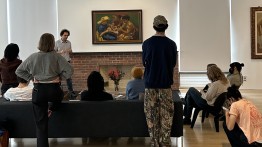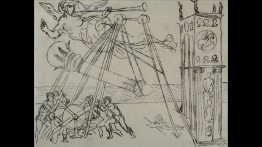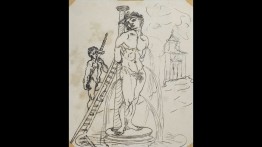Faculty-Curated Exhibition on Jewish Italian Artist Corrado Cagli at CIMA
POSTED ON: November 9, 2023
December 7, 2023
Levere, Jane. "An Artist Shattering Boundaries in Pursuit of Freedom." Review of Transatlantic Bridges: Corrado Cagli, 1938-1948, by Raffaele Bedarida. The New York Times, 7 December 2023.
November 9, 2023
Raffaele Bedarida, associate professor of art history at The Cooper Union, is the curator of a new exhibition dedicated to the Jewish Italian artist Corrado Cagli (1910–1976). Named one of the “15 Art Shows to See in New York This November” by Hyperallergic, Transatlantic Bridges: Corrado Cagli, 1938-1948 is on view at the Center for Italian Modern Art (CIMA) through January 27, 2024. The exhibition is accompanied by a series of talks that place contemporary artists in conversation with critics, curators, and scholars, including Bedarida and other Cooper faculty members.
The exhibition has provided a learning opportunity for Cooper Union students taking courses this semester related to the history of 20th-century Italian art and politics. Students in Bedarida’s class on International Futurism as well as those in a class on fascism being taught by Atina Grossmann, professor of history, visited the CIMA show to learn about Cagli’s life and work.

Transatlantic Bridges presents Corrado Cagli's captivating human and intellectual journey during his transformative years in the United States through drawings, paintings, photographs, and ephemera. “This is the first Cagli exhibition in New York since he left the city in 1948,” says Bedarida. “I hope it will contribute to reconsider a body of work that has been erased from the picture ever since; that should, hopefully, complicate the digested narrative of those years.”
As a Jewish and openly gay artist, Cagli became the target of virulent attacks and fierce criticism under Italy’s fascist regime during the 1930s, leading him to seek refuge in America where he became an influential figure within the New York émigré artistic scene. The CIMA exhibition not only explores themes of war, exile, and discrimination but also highlights Cagli’s multifaceted engagement with the anti-Breton Surrealists of View magazine and the neo-Romantic milieu centered around Julian Levy Gallery and the Wadsworth Atheneum. Additionally, the show sheds light on his collaboration with George Balanchine and the Ballet Society, showcasing the depth and richness of his artistic legacy.
In July, CIMA was awarded a grant from the Andy Warhol Foundation for the Visual Arts to support public talks developed in the context of the Cagli exhibition. Titled Persisting Matters, the series featured artist Sheila Pepe in conversation with Lex Lancaster, assistant professor of art history at The Cooper Union. Bedarida, who delivered a curatorial lecture at the exhibition opening last month, will continue the series with a talk featuring historian Jennifer Homans on December 12. Cooper alumna and former School of Art professor Leslie Hewitt A’00 will also participate in the series with a talk on Wednesday, December 13 at 6pm.

“The most obvious reason for Cagli's relevance today is how his work explores identity not as something fixed or stable but as a multilayered, ever-changing process of negotiation,” says Bedarida, whose scholarship focuses on transnational modernism and politics. “But what really spoke to us when I visited with my Cooper class was the shift from monumental public work to small drawings, in which absurdism, irony, and homoerotic tension are used as tools to mine the ‘civilizing mission’ rhetoric of fascist modernism. They raise the question of humanism—its role, responsibility, and future—while unspeakable tragedy unfolds. I don’t need to emphasize how urgent that question feels right now.”
The English translation of Bedarida’s monograph on Cagli's exile was published by the Centro Primo Levi Editions in concomitance with the CIMA exhibition.







